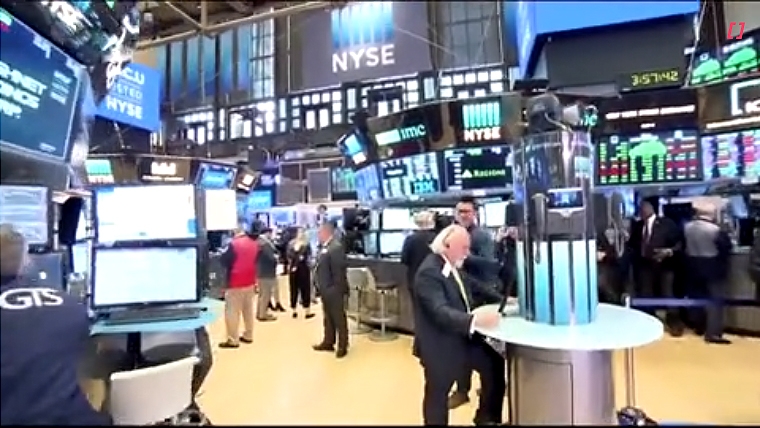
US equities are higher following strong earnings reports from Microsoft and Meta and the ISM manufacturing index didn’t fall as much as expected, even if there are clear signs of cracks opening in the US economy. Sentiment has also been supported by chatter that the US is trying to initiate trade talks with China. These factors supported a lift in US Treasury yields and a broadly stronger USD. The NZD slipped below 0.59 earlier this morning. Many European and Asian markets have been closed for May Day holidays.
Yesterday, there was a report from China state media that the Trump administration has recently reached out to Beijing “through multiple channels” to initiate trade talks, “something China sees little downside in exploring at his stage”. This fitted the theme of trade war de-escalation seen over the latter part of April.
US equities are stronger, supported by better-than-expected results from Microsoft and Meta, while Nvidia was boosted after Bloomberg reported the US is weighing a potential easing of restrictions on its chip sales to UAE. McDonalds reported its largest drop in US sales since the height of the COVID-19 pandemic, down 3.6%, with customers “grappling with uncertainty”. Automaker GM said it will face a $5 billion bill for tariffs in 2025, which it will try to partially offset by reducing spending and shifting some production to US plants. The S&P500 is up over 1% with an hour left of trading while the Nasdaq index is up over 2%. Amazon and Apple report after the close.
The US ISM manufacturing index slipped just 0.3 to 48.7, a much smaller than expected fall, given the guidance by much weaker regional Fed manufacturing indices. The breakdown was mixed, with stronger new orders and employment but a 4.3pt slump in production to 44.0 Respondents reported tariffs as a key issue, which were creating supply chain issues, reducing demand and driving higher inflation.
Initial jobless claims rose 18k last week to 241k, with the spike higher largely attributed to the timing of holidays in New York. Of more interest was the much greater than expected 83k leap in continuing claims for the prior week, alongside another high reading from the monthly Challenger and Co. job cuts series, both foreshadowing a possible lift in the unemployment rate.
The market took more interest in the ISM manufacturing report, and Treasury yields lifted across the curve, driven by the short end. The 2-year rate is up a chunky 10bps for the day to 3.70%, while the 10-year rate is up 7bps to 4.23%.
Yesterday, the BoJ left policy unchanged, but the updated outlook was dovish. Growth and inflation projections were lowered. The Bank said it expected inflation to be consistent with its 2% goal around the second half of the outlook period, while growth for the current fiscal year was halved to just 0.5%. Governor Ueda attempted to convey a message of raising rates as its price goal is within sight, but he wasn’t prepared to give any guidance on timing,
The policy update drove down the yen and higher Treasury yields have added to that move. The yen is some 2% weaker from this time yesterday, seeing USD/JPY up to 145.60. NZD/JPY is up over 1.2% to 86.0.
The USD is broadly stronger, on hope that the US and China can soon engage in trade talks and the better-than-expected ISM manufacturing print. This has seen the NZD trade just below 0.59 this morning before rising back above the figure, and the AUD has sustained a fall below 0.64. While NZD/JPY is stronger as noted, the NZD shows only small falls on the other major crosses. EUR has fallen below 1.13 and NZD/EUR is down a touch to 0.5230.
The domestic rates market showed steeper curves. NZGB rates were down slightly at the very short end of the curve while the ultra-long bonds rose 3-4bps. This was reflected in the weekly tender, with strong bidding for the shorter dated bond on offer and less bidding tension for the 2054s. The 10-year rate closed up 1bp to 4.46%. In the swap market, the 2-year rate was unchanged at 3.06% and the 10-year rate rose 3bps to 3.95%.
Statistics NZ said it made a calculation error for Q1 CPI, which understated inflation by 0.1 percentage point, so the CPI would have risen by 1.0% q/q and 2.6% y/y without the error. The data won’t be revised, as is normal practice, but will feed into inflation for Q2.
On the calendar in the day ahead, the key focus will be on the US employment report, which is expected to show a modest 135k lift in employment and a steady unemployment rate of 4.2%, ahead of the impact from import tariffs. There is upside risk to euro area CPI inflation of 2.1% y/y after higher-than-expected country releases this week.

We welcome your comments below. If you are not already registered, please register to comment.
Remember we welcome robust, respectful and insightful debate. We don't welcome abusive or defamatory comments and will de-register those repeatedly making such comments. Our current comment policy is here.